For the final project, I have decided to experiment with the 3D printer PLA plastic material. More specifically, using failed projects of others and recycling the support for the 3D prints. I wanted to experiment with this because initially I wanted to build the extrusion machine from precious plastics but NYU Shanghai lacked the resources to build this machine on our own and it would also take some time. When I watched the extrusion machine video, one of the things they did was recycled PLA plastics into 3D printer filament and I thought that was an amazing idea. After talking to Andy and Marcele though, I realized that this was something impossible to do for me because the 3D printer is actually very sensitive in terms of the quality of the filament, the length, the width, and it is very difficult to actually re-use the filament for the same purpose. So I began to experiment with the material and I wanted to try to melt it first and see what it would look like. In the big box of used 3D filament, there were couple different categories to separate.
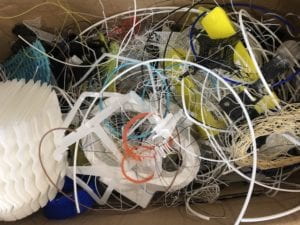
Within the big pile of filaments, I sorted them into three different categories.
Support:
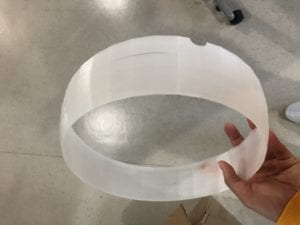
Scraps of filament:
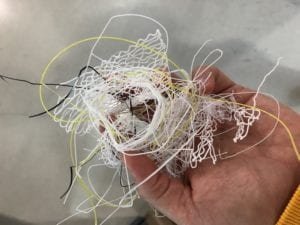
The actual filament that was thrown out:
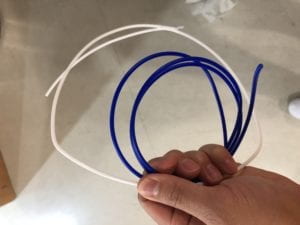
I decided first to melt them separately so I could see the effect of each filament. I first picked up some scraps of filaments and I did not cut them or anything I just piled them closely with each other and I put them in the oven. I set the oven to about 180 degree celsius and with these scraps, since they are very thin, the moment I put them in the oven it had already softened. After 20 minutes, they were a bit melted but not the the point I want them to be. I left it for another 10 minutes and they were pretty much melted. I took it out of the oven and I tried to scrap them up but they were accidentally rolled into one. 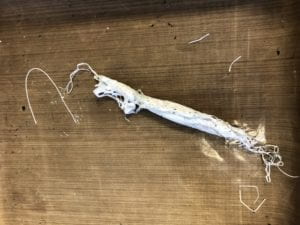
After finish testing this type of filament, I then moved on to the actual 3D filaments. I tried cutting them up into small pieces with a scissor but they were pretty tough to cut with so I used the plastic shredder so shredded them up to small pieces.
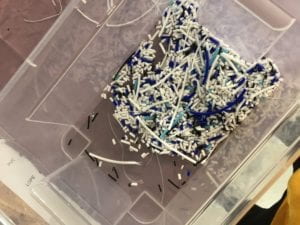
Then I put them all into the oven pan and aligned them so that they are in a square like shape. This time, it took about 40 minutes to melt the whole thing since it was much thicker than the scraps. After 40 minutes, I took it out and it turned out to be a slab of plastic that looked a lot like the stool that we made in class. 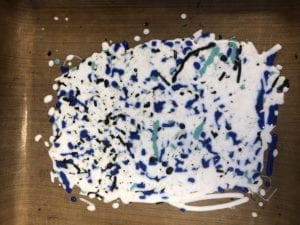
It was not completely melted though so it had some rough texture to the slab and I actually kind of liked it. I thought about what I would made out of it and I saw some ideas from precious plastics creations. One of the idea that I really liked was a wall clock made out of plastic.
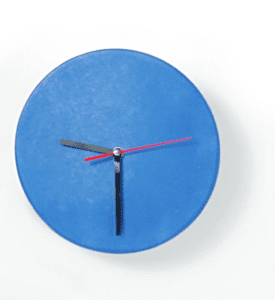
However, I would need to buy some materials from Taobao but this is just an initial idea that I have and it might change later on.
Final Project Documentation
For my final project, I have decided to create a PLA material library for future references. This idea came about from talking to Andy after working with him. I’ve created 8 different kinds of sample all from the PLA materials that was used for the 3D printer. I created all the samples with the same technique by melting them in an oven. I left them in the oven at about 200 degree celcius for an hour. The purpose of that was also to make it more accessible for people at home, schools that has 3D printer accessible to them, and also places that has a fabrication lab.
I melted 4 samples only using only the actual filament which I call them the pure filament, 2 that were mixed of materials, and 1 support filament which had a much stronger texture. 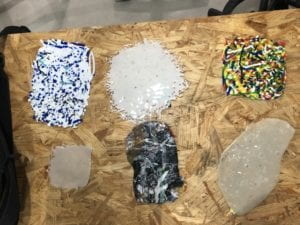
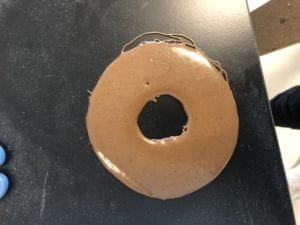
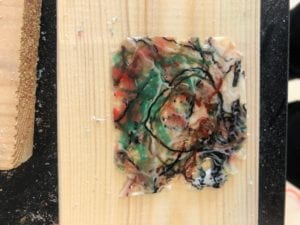
Through out this experiment, I created some amazing pieces that were well liked by others as well. When I took the pieces out of the oven, I really thought the colors and texture was cool. When it just came out of the oven, it had a really glossy look and since it was still melting it looked soft and bendable. When it cooled down, the glossy look went away but the colors were still amazing. The colors and the texture really reminded me this skateboard brand called Penny Skateboard and the back of their boards always has cool colors.
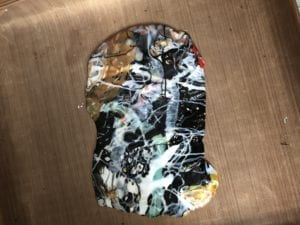
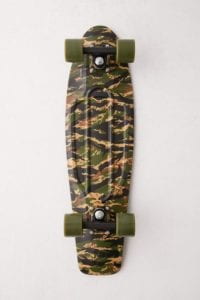
Therefore I really wanted to create something like that but due to the time constraint I couldn’t. This was another idea that I had other than the clock and I would definitely want to try to do this if I had the time. Overall, I felt that this project was very fun to work with and I had some discoveries about PLA material as well.
For example, when you melt a filament that is transparent, when it is first melted, it stays transparent but then as it cools down, it turns into an off-white color.
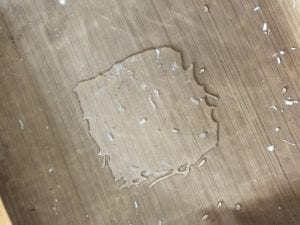
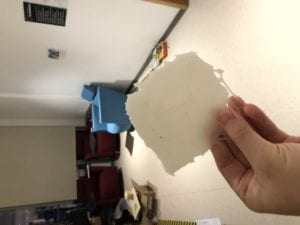
Final Product
For the presentation, since I wanted to make a material library, it was best if i could make them similar to something like this
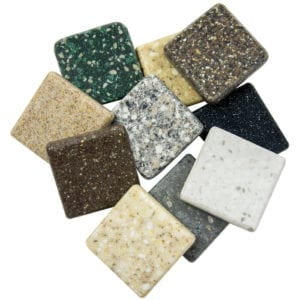
Therefore, I decided to use a saw and cut them up into little square.
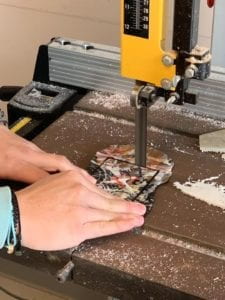
For the final result, it turned out to be like this.
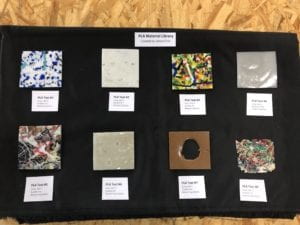
And I put a name tag for each one of them.
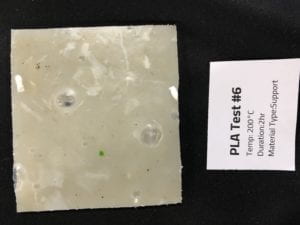
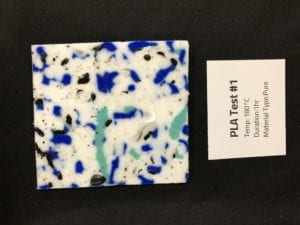
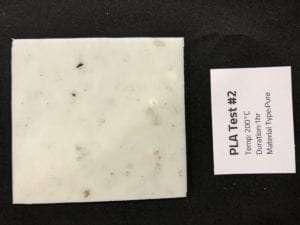
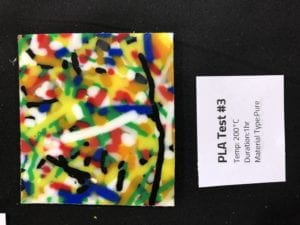
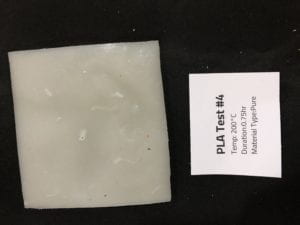
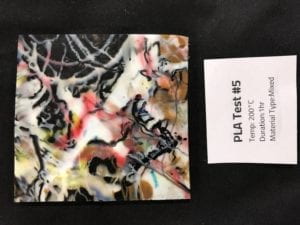
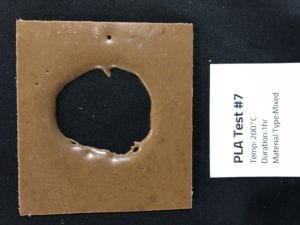
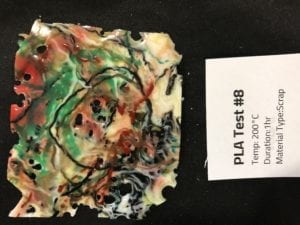
Conclusion
For this project, I had a lot of fun making these samples and really got to explore a type of plastic that I never really interacted that much with. One concern that I had was that before going into this project, I thought I would be utilizing the whole box of failed 3D prints but after finishing this project, I feel like the amount of failed 3D prints and PLA materials that was in that box didn’t decrease at all. My question was that how can we decrease the amount of PLA waste? There are only 2 to 3 companies in the world that are able to re-use the 3D print PLA material for printing again because that it very difficult to do but for schools and individuals who owns a 3D printer, what can they do with these wastes? It is important to acknowledge that these waste are inevitable. It is quite impossible to never have failed 3D prints so trying to make every print perfect isn’t a good solution. I think this is something that could be done in the next step and for further research. My project was merely just the start and for people who are interested in recycling PLA material, my project was just to show one form of recycling by melting it but there are still so many ways to explore it.
One of the professor at the presentation suggested that I could mix it with different materials like wood, glass, or paper and see what happens. This is something that others could explore and I would be very interested to see how it turns out. In conclusion, I really enjoyed this class as whole and really go to understand the relationship between plastics and our environment and to be honest, it is a little bit upsetting because it is so hard to be sustainable when everyone could care less about it. It is upsetting and disappointing to learn all about the waste humans produces. I hope a course like Re-made in China and or other sustainability classes can be taught at every school as a core class to take so that everyone could be at least a bit more mindful about the waste we produce.
Leave a Reply